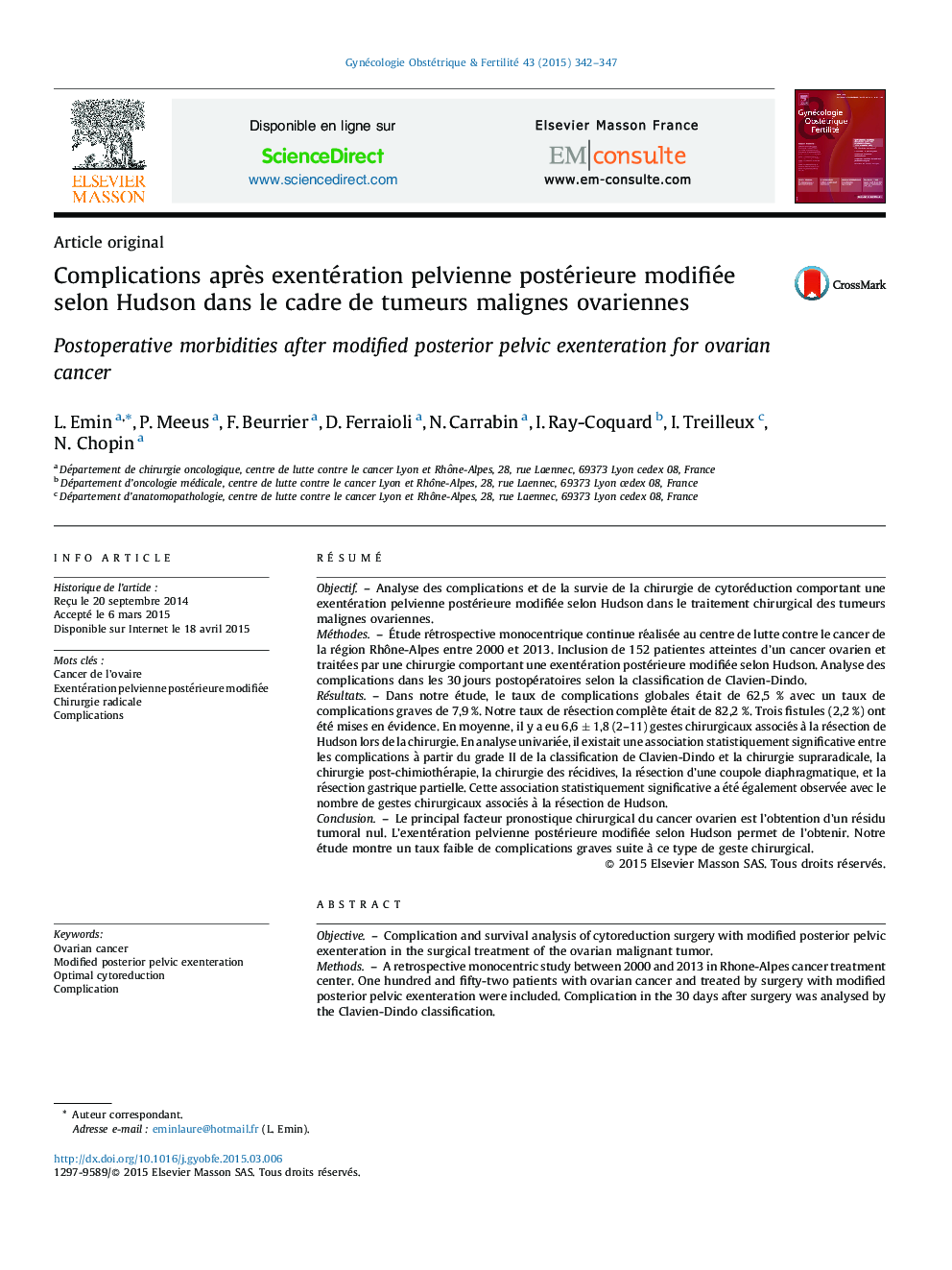| کد مقاله | کد نشریه | سال انتشار | مقاله انگلیسی | نسخه تمام متن |
|---|---|---|---|---|
| 3949131 | 1254687 | 2015 | 6 صفحه PDF | دانلود رایگان |

RésuméObjectifAnalyse des complications et de la survie de la chirurgie de cytoréduction comportant une exentération pelvienne postérieure modifiée selon Hudson dans le traitement chirurgical des tumeurs malignes ovariennes.MéthodesÉtude rétrospective monocentrique continue réalisée au centre de lutte contre le cancer de la région Rhône-Alpes entre 2000 et 2013. Inclusion de 152 patientes atteintes d’un cancer ovarien et traitées par une chirurgie comportant une exentération postérieure modifiée selon Hudson. Analyse des complications dans les 30 jours postopératoires selon la classification de Clavien-Dindo.RésultatsDans notre étude, le taux de complications globales était de 62,5 % avec un taux de complications graves de 7,9 %. Notre taux de résection complète était de 82,2 %. Trois fistules (2,2 %) ont été mises en évidence. En moyenne, il y a eu 6,6 ± 1,8 (2–11) gestes chirurgicaux associés à la résection de Hudson lors de la chirurgie. En analyse univariée, il existait une association statistiquement significative entre les complications à partir du grade II de la classification de Clavien-Dindo et la chirurgie supraradicale, la chirurgie post-chimiothérapie, la chirurgie des récidives, la résection d’une coupole diaphragmatique, et la résection gastrique partielle. Cette association statistiquement significative a été également observée avec le nombre de gestes chirurgicaux associés à la résection de Hudson.ConclusionLe principal facteur pronostique chirurgical du cancer ovarien est l’obtention d’un résidu tumoral nul. L’exentération pelvienne postérieure modifiée selon Hudson permet de l’obtenir. Notre étude montre un taux faible de complications graves suite à ce type de geste chirurgical.
ObjectiveComplication and survival analysis of cytoreduction surgery with modified posterior pelvic exenteration in the surgical treatment of the ovarian malignant tumor.MethodsA retrospective monocentric study between 2000 and 2013 in Rhone-Alpes cancer treatment center. One hundred and fifty-two patients with ovarian cancer and treated by surgery with modified posterior pelvic exenteration were included. Complication in the 30 days after surgery was analysed by the Clavien-Dindo classification.ResultsIn our study, rate of global complication was 62.5% with a morbidity rate of grave complication of 7.9%. Our rate of complete resection was 82.2%. Three fistulas (2.2%) were found. On average, there was 6.6 ± 1.8 (2–11) surgery gesture associated with Hudson resection during surgery. In univariate analysis, there was a statistic significant association between complication from the rank II of Clavien-Dindo classification and supraradical surgery, post-chemotherapy surgery, recurrent surgery, the resection of a diaphragmatic dome, and the partial gastric resection. This association was also observed with the number of surgical gesture associated with Hudson resection.ConclusionsThe main prognostic surgical factor in ovarian cancer is to obtain a no macroscopic residual disease. The modified posterior pelvic exenteration allowed to obtain it. Our study demonstrates a low rate of grave complication further to this type of surgery.
Journal: Gynécologie Obstétrique & Fertilité - Volume 43, Issue 5, May 2015, Pages 342–347